Inflation touches 44-month peak at 5.2%
Higher petroleum product prices, rupee weakness fuel the rise in CPI

A private research house on Wednesday predicted that inflationary pressures were likely to remain in place in the new fiscal year due to currency rate adjustments, higher crude prices and recent budgetary measures.
PHOTO:EXPRESS
Measured by the Consumer Price Index (CPI), the average increase in prices of 40 dozen items was calculated at 5.2%, reported the Pakistan Bureau of Statistics (PBS) on Wednesday. It was the highest level since October 2014 when inflation stood at 5.8%.
After that, it had started slowing down and at one stage dropped below 2%. However, the increase in prices of petroleum products and the weakening rupee against the US dollar since December 2017 fuelled inflationary pressures in the country.
In March: Inflation slows down for 3rd successive month, stands at 3.2%
Many retail outlets that have pegged prices of daily-use commodities with the dollar have jacked up the rates by 20%. There was a one-percentage-point increase in inflation in June when compared with May 2018, reflecting the impact of higher oil prices and currency weakness.
In order to rein in inflation and correct other macroeconomic imbalances, the State Bank of Pakistan (SBP) on May 28 increased the key policy rate by 50 basis points to 6.5%. In its monetary policy statement, the central bank acknowledged the building up of inflationary pressures as core inflation had started going up suddenly. PBS data showed that core inflation rose further to 7.1% in June compared to the same month a year ago, which was higher than the SBP’s policy rate.
Owing to the increase in the policy rate, the government’s cost of borrowing through Pakistan Investment Bonds has also jumped. Apart from this, the finance ministry has approved increase in profit rates of National Savings Schemes in the range of 12 to 50 basis points.
Brace yourself for inflation as the rupee takes a hit
Another round of currency depreciation and a further rise in the policy rate - at which the central bank lends money to commercial banks - are expected at a time when Pakistan will seek another bailout programme with the International Monetary Fund (IMF). Average inflation in fiscal year 2017-18, which ended on June 30, stood at 3.92%, far below the 6% target and lower than the inflation rate in the preceding year. Inflation was the only major macroeconomic indicator that remained within target in the last year of the PML-N government.
Forecasting inflationary trends, the SBP in its policy statement said a significant change in the outlook for international crude oil prices, strong demand, lagged pass-through of exchange rate adjustments, food inflation maintaining its current course and inflationary expectations would largely determine the inflation path for fiscal year 2018-19.
A private research house on Wednesday predicted that inflationary pressures were likely to remain in place in the new fiscal year due to currency rate adjustments, higher crude prices and recent budgetary measures.
According to PBS data, on a year-on-year basis, kerosene oil price jumped 34.3% and petrol price rose 17.3% in June. It did not report price increase for high-speed diesel. A main reason behind the higher petroleum prices was high taxes on them. The cost of education services increased 13%, followed by a 12% rise in prices of newspapers, 10.5% increase in construction wages, 10.2% increase in water supply charges and over 9% increase in the cost of personal equipment. Average medical test and doctor’s fee went up 8.5%.
Core inflation reaches 7% for first time in 41 months
In the food group, the cost of betel leaves rose 190% after the levy of regulatory duty. Chicken prices jumped over 26%, followed by a 16% rise in prices of tomatoes, 14% in onions and 10% in dry fruits. Meat became expensive by about 10%. Prices of pulses decreased in the range of 13-26% in June over a year ago.
Published in The Express Tribune, July 5th, 2018.
Like Business on Facebook, follow @TribuneBiz on Twitter to stay informed and join in the conversation.



















COMMENTS
Comments are moderated and generally will be posted if they are on-topic and not abusive.
For more information, please see our Comments FAQ